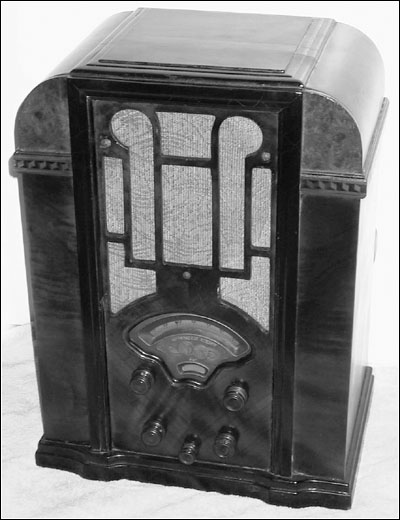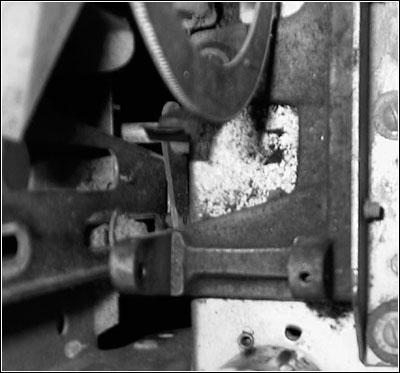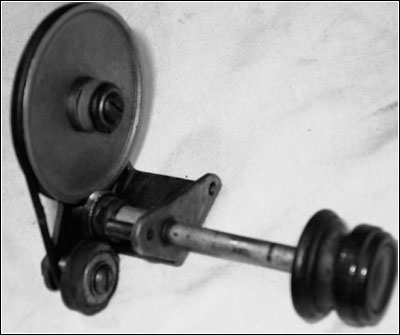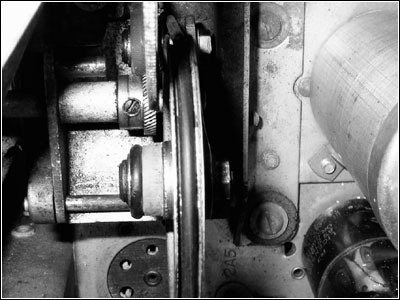Of Old Radios And Related Items--Published Monthly
Restoring an Atwater Kent 447
An American ClassicBY CLAUDE CHAFIN
Web Edition
Giving an unusual radio a second chance is Claude Chafin's big contribution to the radio collecting community. Once again he takes a potential candidate for the trash and preserves it for radio history. (Editor)
Here is a story radio collectors should love. It is about an Atwater Kent Model 447, which, to me, is a classic radio! In fact, I've talked to other collectors who all agree that this set is rare, hard-to-find, and extremely desirable in the collecting community. However, just because a set is rare doesn't always make it desirable. This one is both. That's why I call it an "American Classic." Figure 1 shows my radio after restoration.
The Atwater Kent 447 has all the makings of a truly unique radio. Built about 1934, it operates on AM and sports four bands -- one BC and three shortwave. It uses seven tubes and has shadow graph tuning. Its controls are coarse and fine tuning, tone, and off/on volume.
Figure 1. My Atwater Kent Model 447 after restoration.I found this set in a garage sale for $20 in the summer of 2005. When I first saw it, I could understand why the lady told me that If I didn't buy it, she was going to throw it in the trash. Pretty scary! I considered offering her $10, but then thought better of that idea. So I paid her the $20 and brought it home.
The Cabinet
My motto is "Never make a job harder than it already is." In all, I probably did regluing and repairing on about 50 percent of this set.
The cabinet has marquetry trim with a fancy grille and grille cloth and five wooden knobs with black lacquer trim. It needed some work, which I did quickly after removing the chassis. In fact, the cabinet is not stout enough to handle the weight of the chassis. If you picked it up by its top you might be sorry -- a design flaw. That's probably what had happened because the top had come loose and required gluing.
The base too had become separated and needed to be reglued. The grille had been broken and had to be reveneered in a few places. But, I lucked out with the grille cloth, which was the original and was undamaged with no stains.
Figure 2. The dried rubber and toothed drive wheel produced lots of ground-up rubber.Once I had done the repairs, it was only a matter of adding lacquer and toner to the finish. The black lacquer trim needed some touching up, but I left the sides of the cabinet alone as they were still intact and had toner on them already. The few surface scratches disappeared quickly with a light coat of satin lacquer.
Sides of cabinets are often undamaged, so why strip them? Besides, you will never match the toner color anyway. Too many people get in a hurry with stripper and then it ends up looking worse.
The Chassis
While the chassis was out of the cabinet, I examined it. How the tuning mechanism worked was my first question. I had never seen anything like this one before. It was quite the mystery.
Then I noticed some old dried rubber on the gear drive section. Figure 2 shows the rubber dust created by the wear on the dried rubber drive. What I had found was the old rubber section that butted up against the metal gears, and this was what was used to drive the tuning capacitor.
Figure 3. The 2-speed tuning mechanism used in the Model 447.The entire tuning drive section pivots on a hinge held in place by one set screw. It has a metal tensioner that keeps the rubber positioned against the gear drive. Figure 3 shows the 2-speed tuning mechanism. I removed that section.
Then I scrounged around for some rubber washers and grommets to replace the worn rubber drive. I also added a rubber belt using some small rubber styrene for the fine tuning side and replaced all the old rubber. Figure 4 shows the rebuilt tuning mechanism. The chassis was now ready to reinstall.
Atwater Kent built this set to tune in two different modes, coarse and fine. To switch from one to the other you merely push upward on the tuning knob as if it were a gearshift. Push downward, and it goes into a fine tune mode. That's why the hole for this control in the cabinet is somewhat bigger.
Figure 4. The tuning mechanism after restoration.The tuning mechanism is a great Idea but it was a bad design. Atwater Kent, like other manufacturers, did not take into account that the rubber would deteriorate over time. Thus, today there probably are not many Atwater Kent 447s functioning properly.
Not many of this model were made, as it was priced high in the middle of the Depression. So, as you might imagine, not many got sold. If you own one, consider yourself lucky. I know I do.
(Claude Chafin, 4223 E. 42nd Way, Independence, Missouri, 64055)
Claude Chafin, an old radio collector for 15 years and a Ham operator for 25, asks three questions before taking on a repair job: Will his techniques bring it back to normal? Is it too far gone to make the time spent worthwhile? And, does it have a good collectible potential? Affirmative answers mean success, as in this article.
| [Free Sample] [Books, etc., For Sale] [Subscribe to A.R.C./Renew] [Classified Ads] [Auction Prices] [Event Calendar] [Links] [Home] [Issue Archives] [Book Reviews] [Subscription Information] [A.R.C. FAQ] URL = http://www.antiqueradio.com/Mar06_Chafin_AK447.html Copyright © 1996-2006 by John V. Terrey - For personal use only. Last revised: February 26, 2006. For Customer Assistance please contact ARC@antiqueradio.com or call (866) 371-0512 toll free Pages designed/maintained by Wayward Fluffy Publications
Antique Radio Classified |



